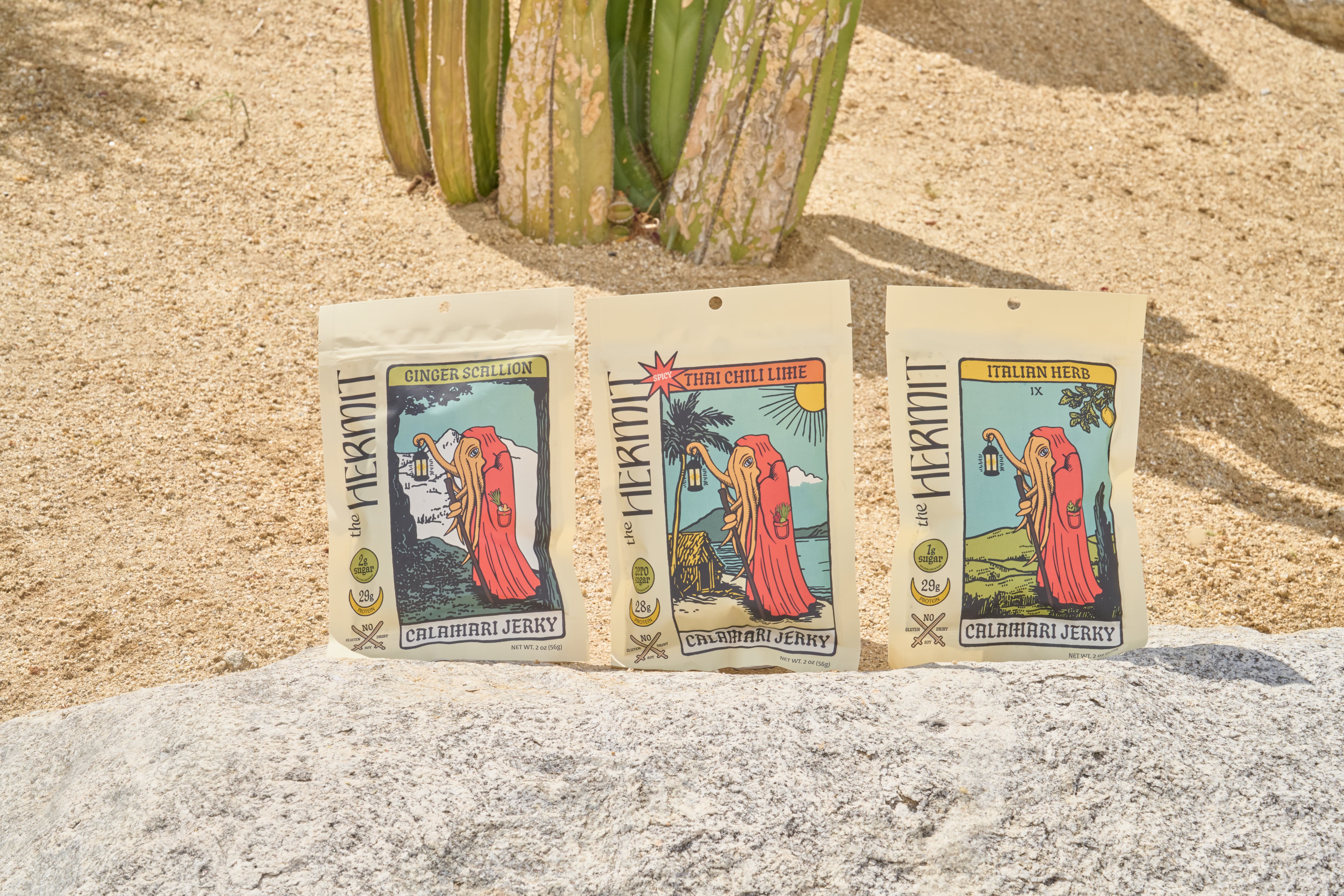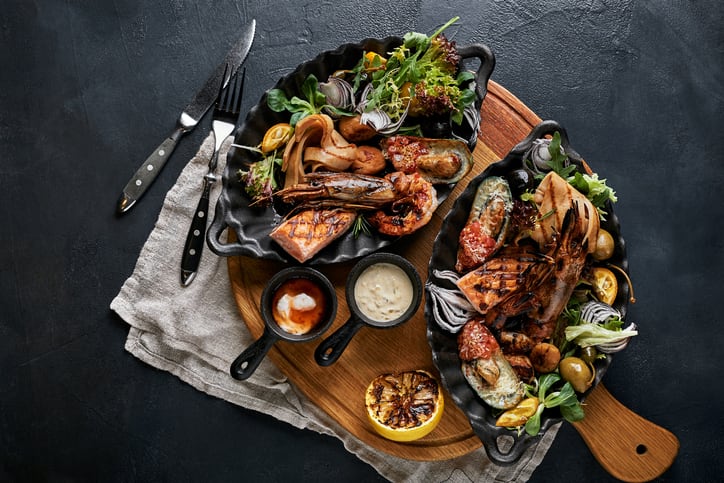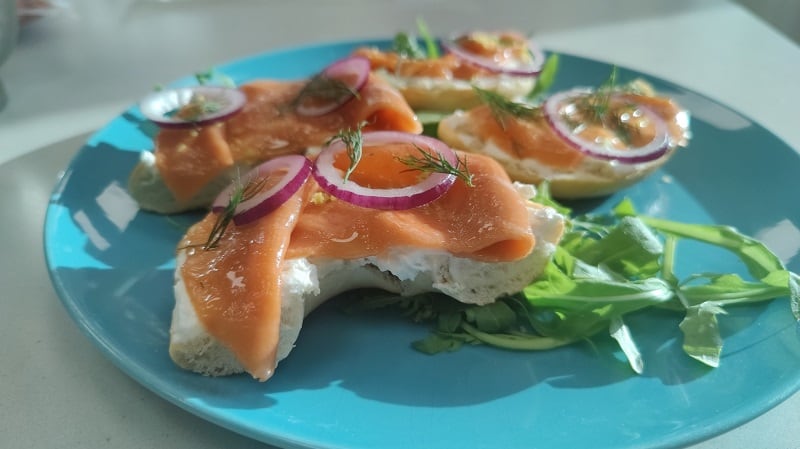Startup brand, The Hermit, is bringing a novel twist to the jerky category with an MSC-sourced, Whole30-compliant squid snack designed for today’s protein-driven consumer.
Two years after leaving his finance-tech career in New York City to follow his partner to Bangkok, Thailand, Steven Shonts founded The Hermit, a dried calamari jerky brand that officially launched DTC two and a half months ago.
With three flavors – Thai Chili Lime, Ginger Scallion and Italian Herb – The Hermit’s calamari “chips” deliver Whole30-compliant nutrition, up to 29 grams of protein per two-ounce bag and no added sugar. For context, fish jerky brand Kaimana Jerky contains 18 grams of protein per two-ounce bag and 12 grams of added sugar.
For Shonts, the inspiration started in Asia, where squid is commonly consumed. “Squid is very ubiquitous protein, not just in Thailand, but in all East Asia. It’s almost like a staple protein source. I was very interested in sustainable protein, and it just very quickly became clear I want to focus on squid,” he said.
Sourcing with purpose: MSC-certified squid and a vision for Thai fisheries
While squid suppliers are plentiful across Asia, The Hermit opted against sourcing there for now.
“Using a Southeast Asian source squid would not work [for] product right now,” said Shonts, citing the lack of Marine Stewardship Council (MSC) certification that retailers like Whole Foods require.
Once the brand expands more, Shonts says he hopes to help a Thai fishery obtain MSC certification “or something comparable.”
“That would be a pretty big tune for the fisheries in Thailand, because it would open up new markets to them. They could charge more money for their squid. It’s just that’s going to be a multi-year effort,” he added.
The Hermit’s initial production run used MSC-certified Town Dock squid from Rhode Island. Going forward, it is switching to Del Mar squid sourced from MSC-certified fisheries in Monterey, Calif.
Del Mar squid will help The Hermit scale since the species are known for its climate resiliency and adaption to pollution, with migration patterns expanding as far north as southern Alaska, Shonts said.
He added that Del Mar’s purse seine method minimizes unintentionally caught marine life and avoids destructive bottom trawling. Purse seine, which traps fish inside a large circular net that is pulled shut like a drawstring bag, is often considered more sustainable than traditional methods like bottom trawling – a method that drags a large heavy net across the sea floor by boats and scoops up other sea life like corals and sponges.
From blanch to bag: How The Hermit approaches texture
In a US market still dominated by beef jerky, introducing squid required careful consideration around preparation, according to Shonts.
“I traveled a lot around East Asia and Southeast Asia, and I’ve eaten hundreds of different types of the product. The diversity of preparations is really astounding,” he said.
For The Hermit, Shonts focused on a dry, shelf-stable preparation without adding sugar, which is a common ingredient in dried seafood. For jerky, sugar traditionally serves as a humectant for a more tender squid. For The Hermit’s texture, Shonts relies on careful sourcing and processing where the freshly caught squid is quickly blanched right out of the water and then frozen to lock in tenderness.
The brand worked with an R&D firm in Berkeley to transform dried squid into a snack with the familiar chew of jerky but without added sugar. “We were able to come up with something that was palatable,” and “we have to modify the cook cycle and the marinade process in order to achieve a texture that is acceptable. A lot of what you get in Southeast Asia is extremely chewy. Through a lot of R&D, we were able to get that to a place that we say it’s like classic jerky texture,” Shonts explained.
The Hermit’s sugar-free preparation allows for the product to be Whole30-compliant, he added.
Finding the balance between cultural flavor and familiarity
Flavor selection was equally intentional, Shonts said. He looked into recipes rooted in his culinary life in Thailand but also accessible to American palates.
“I initially had a very specific Thai flavor set in mind,” including coconut milk and cilantro, but those ingredients would not technically translate during the meat drying process. Instead, Shonts and the R&D team landed on a balance of familiarity and novelty, like Ginger Scallion, a popular flavor combination for fish in Thailand, and Italian Herb which is well known in the US, he said.
The jerky’s shape – flat, chip-like pieces – was also designed with practicality in mind. Shonts noted that cutting squid into uniform “rings” does not work well for jerky dehydration. The Hermit’s California supplier will enable a butterfly cut that maintains consistency, he explained.
With the new California supplier, Shonts plans to scale back the spice blend, reducing some of the non-protein ingredients. That adjustment would allow for a higher proportion of protein-rich base ingredients, potentially raising the protein content to 32 grams per bag, he said.
Squid jerky for the macro counters and clean eaters
The Hermit arrives in a market where protein has become nearly ubiquitous across categories.
For the brand, the appeal is twofold: meeting “macro counters” who chase high-protein intake, and clean-label seekers who prioritize whole food sourcing.
“We’re kind of relying on a lot of intuitive feeling on the part of the consumers,” where “one, it’s a whole animal, whole meat cut, and it’s pretty hard to fake that. And then two, it’s the same thing of an intuitive understanding that seafood is sort of healthier,” he added.
Squid also brings differentiating nutrients beyond protein with collagen.
“Our squid is extremely high in collagen. It’s like one of the most collagenous seafoods,” and The Hermit contains up to “12 grams in our last batch. That’s a nice value-add,” Shonts noted.
Symbolism meets snacking: What does the Hermit mean?
The Hermit’s branding features a squid as the hermit, a nod to the tarot deck that his late mother gave him, and a card that continued to reappear for him as he set out to Thailand.
In tarot, the Hermit represents introspection and the search for clarity, a theme that paralleled his own culinary journey abroad. That exploration ultimately inspired him to develop a snack rooted in health and sustainability, sourcing squid responsibly under the MSC’s strict wild-caught seafood standards to help preserve the species’ population.
While Shonts was inspired by the tarot, he notes that the brand is for everyone looking for a clean, nutrient-dense and sustainably-sourced snack.
Bootstrapped growth: The Hermit is scaling on its own terms
The Hermit has been entirely bootstrapped so far with savings from Shonts’ previous career, along with a few friends who offered to help fund the company. Shonts intends to self-fund as the brand grows and is reluctant at this point to take on outside capital.
For now, sales are direct-to-consumer via Shopify, but Shonts plans to pitch US retailers this fall.
“We have a list of 160 retail locations that are almost all independent or very small chains,” that are “focusing on seafood-forward regions like the Pacific Northwest and coastal New England, where we’ve gotten the most intense interest and reorders,” he added.




